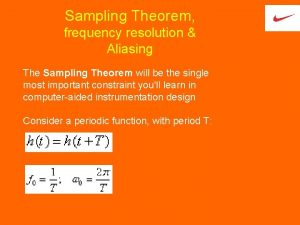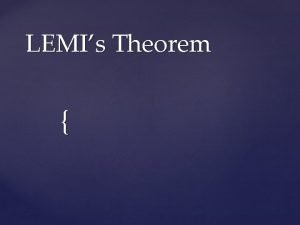DATA COMMUNICATION PRINCIPLES The Sampling Theorem The Sampling




- Slides: 4

DATA COMMUNICATION PRINCIPLES : The Sampling Theorem

The Sampling Theorem Consider a continuous signal with a frequency spectrum between 0 and B Hz. According to the sampling theorem, all the information in this signal is preserved in its samples taken at a rate of 2 B samples per seconds (bauds) or higher. Example 3 -1: Speech signal is analog with bandwidth within 4 k. Hz. If a speech signal is sampled at a rate of 8000 samples per second or higher, these samples contain all the information in the original signal. Now we look at the example of transmission of analog speech (data) using digital signals. Figure 3 -17 shows the sequence of events before a speech signal is completely converted into binary form. Figure 3 -17(a) shows an analog signal, such as speech. Let B be the highest frequency component in it. Then, according to the sampling theorem, samples taken at a rate of 2 B bauds would preserve the information content of the signal. This gives an inter-sample time of 1/2 B seconds. If B = 4 k. Hz, then 1/2 B = 0. 000 125 seconds or 125 microseconds (msec).

These (analog) samples can have any value from an infinite number of possibilities. Therefore, the next step is to limit these samples in having a value from a set of finite values (digital samples). This process is called quantization and is explained further when we discuss pulse- coded modulation. After the signal samples have been quantized, the next step is to represent their values in binary form. This results in the conversion of an analog (speech) signal into a string of binary numbers. This binary data can be transmitted digitally using many of the baseband or passband modulation schemes. One particularly interesting scheme is the pulse-coded modulation (PCM). PCM and its variants, such as adaptive PCM (APCM) and adaptive differential PCM (ADPCM) have been extensively used for voice communications on digital links since the 1960 s and continue to be popular in today’s multimedia networks. It may be recalled, however, that for a computer communications network, the voice digitization simply provides the data part of the application PDU.

REFERENCES • Ahmad A. - Data Communication Principles. For Fixed and Wireless Networks • Cornelius T. Leondes - Database and Data Communication Network Systems, Three-Volume Set_. . -Academic Press







